April 25, 2008
Back in the Day: 1992-3
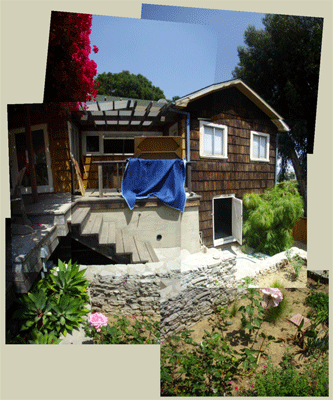
We're having termite treatment done to the house and the service guy told me that he wanted to get underneath a pile of paintings that I had stacked in a corner below the house. Cool. I wanted to clean off the cobwebs and repack them anyway. Along the way, I can post this blog entry to document a brace of paintings that I had made a couple of years out of grad school.
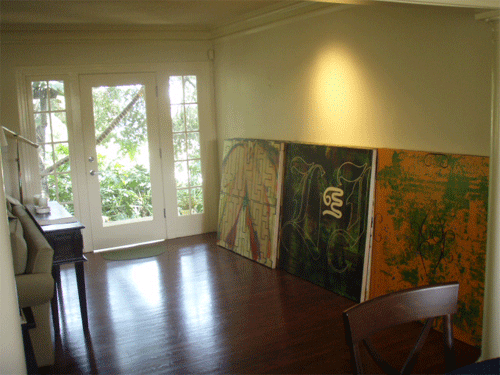
Let's take a closer look at them...
(BLOGPOST IN PROGRESS)
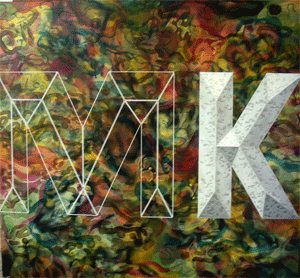
The story behind these paintings goes like this:
I like to say that to be an artist is to recognize one's affinities and make them vivid for others. That's fine as far as art in the broadest aspect but even though there are many art worlds, there is also a specific art world identified by a relation to a dialog, an entity which many in the art world take to be singular and known but most times it is multiple and contested. My affinities settled on painting long ago. I was a kid of about fourteen when I stood in front of Goya's "Saturn Devouring His Children" in the Prado, my mind dilating with lumps of paint and pain.

Grad schools generally do a good job in initiating folks into the labyrinth that is our international art dialog. During 1989 to 1992, the dialog... can best summed up by what came to be the Eli Broad Collection. It's a summary of art in the postmodern era and it appeared to me that the dialog had reached its' apotheosis when it embraced death: the death of the author, the death of painting. I don't want to write a book about it (yet), so the best summary I can offer is in the blogpost Be Mistrustful of History:
Instead of touching G-d through material means, they endevored to touch everyday life through conceptual means.I love the Lawrence Weiner quote: "We had to question the answers given to us in school." Artists at the end of the fifties and the beginning of the sixties questioned the answer of high modernism and flipped it on its head. A true revolution, Coprenican, like the invention of zero or negative integers. A cone of innovation reached an apotheosis and disappeared at its zenith. And what appeared was a raging mountain stream, a torrent of innovation that prized the conceptual over the material. Pop was followed by the Minimal, followed by the Conceptual, followed by Theory. The fruit of the postmodern tree was the conceptual, to be sure (Sol LeWitt, as far as I'm concerned). Art had to be dematerialized. It had to be in its essence, an idea. The stream flowed and broadened over time into a grand and stately river, soon into a slow and wide delta. That is where we are now: silted, fetid, and oozing out to sea, to be evaporated into oceanic clouds, ferried along the winds to mist the mountaintops.
Once again.
And what of painting? Implicated by its materiality, dammed as the ultimate patriarch of art, painting had to play the fool to get along after the inversion of the pyramid/cone, the revolution. Painting had to decry itself: bad painting, the Homer Simpson guise, the anti-aesthetic, the turn of the volume of paint to zero, the monochrome, reductions of all sorts, the subordination of paint to other art forms (photography, for instance). To be a painter in the thirty years before the 90's, one had to hide the paint in one way or the other, one had to paint in alienation.
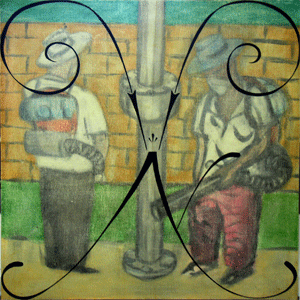
The underlying philosophical implication was a contest between free will and determinism. The revolution of 1968 took refuge in the latter in order to deliver the "better" world it was seeking, blinded by zeal to the dangers of totalitarian abyss. The transgressive mandate of Western art was becoming scumbled into a nihilistic embrace of death, something I tried to address in Personal, Difficult Things. A counter revolution compelled the rejection of death. The blur of the line that divides the imagination and reality spawned suicidal tendencies as an emergent phenomenon. As the popular expression goes: no harm, no foul. Is this true for our art world any more? The visual arts has long enjoyed this special license, something the design arts has not been able to share. I'm thinking of the case of architecture, where there exists a professional mandate identical to that of physicians to do no harm. Designing a building that will collapse and kill its' occupants is contemplated not even for a millisecond. Death is a no-go, especially when it become vividly possible. But now I have begun to wonder about this special artistic license of ours.
We must become the moth that knows the flame will kill.
Against the utopian impulse that provokes determinism, civilization requires that free will must prevail. Freedom and individualism and dissent. This is, it seems to me, the very soul of art. Without this, art itself -our dialog- would die.
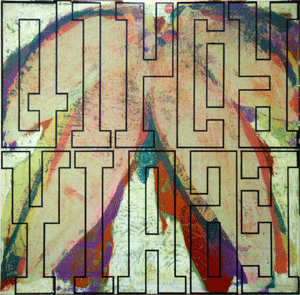
The postmodern epoch had reached a fullness and the next era won't be born until those who are involved in the dialog begin an exhaustive auto-critique. The song for musical chairs was playing and no one was willing to get out of their seats... I guess that's natural but even the fall of the Berlin wall wasn't enough to provoke an epochal self examination. Violins and burning cities. As the next decade and the next pretended that a postmodernity that bloomed from 1950 to 2010(?) would be good enough for the century to come. This, I found doubtful.
I didn't think that it would be interesting or desirable to add another brick to that overdetermined edifice.

I wanted to paint instead, in affirmation.
The question was how to start.

I started with a sandwich. I wanted to sandwich a background painting with a foreground painting. In this way, I could paint anything that caught my eye, I could range. And later I could close the painting by striking a foreground like a cancelled stamp in the post office.
A battery. Two things become more than a third. Such a strategy was in the Ed Ruscha universe when the foreground was a barrier to the background. A gate or fence barring the way to the Eden of unselfconscious painting. Ed Ruscha, the postmodern figurehead for the West Coast. But what if you run the Ruscha program in reverse? What if the foreground began to merge with the background? A chameleon. Sympatico aesthetics.
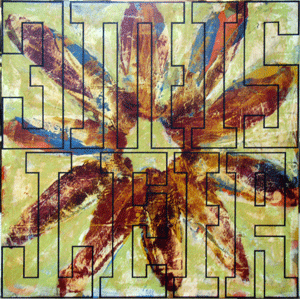
I worked in what I call a full spectrum Darwinian mode. Most people know about "Survival of the Fittest", natural selection in a time of scarcity. But how is it that we tend to ignore the compliment: a proliferation of types in a time of plenty? Therefore I proliferated types and selected the best from them, cycling braces of work and streaming definitive simultaneous lines of inquiry:
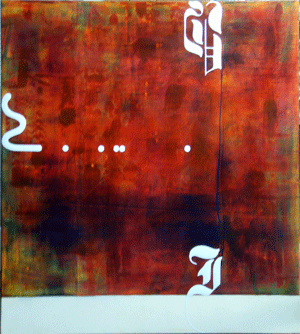
Detail.
-"Glaze Paintings" made from successive coats of transparent alkyd glazes. Puddles of colored jellied glaze were dropped onto the canvas, the slender finger of paint in free fall became a different kind of drawing implement. Drawings. A drywall knife flattened the alkyd mass. Drawing and erasing. Early stencils (they were less like stencils in the repeatable aspect of stenciling than the unique technique delivered by custom friskets, which is what I was doing... it's just that the term "stencil" seems more handy than the term "frisket") emphasized the barrier of foreground versus background like prison bars. Later foreground stencils mapped the substrate in a way that reminded me of my time in the Navy, those years in Combat Information Center.
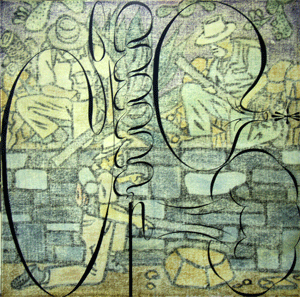
-"Leaf Blower Paintings" where conventional figure paintings using the ubiquitous leaf blower worker (allowing me to pay homage to Diego Rivera -we traveled to his home town in Guanajuato back in '88) was scrubbed and sanded down, the paint back into the weave of the canvas, perhaps erasing na?vet? from simplistic figuration. The final element of the sandwich began to emulate the pneumatic action of the man/machine.
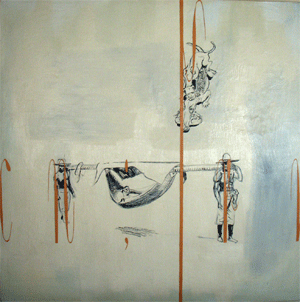
Detail.
-"Wet into Wet paintings" where as I applied a wet brush into wet paint, I realized that there was something special going on. A loaded brush, a loaded support, a loaded subject... the brush spent itself with the turns of fingers, wrist, arm and body into the bed of paint as I chased a representational objective. I wiped the brush and loaded it again and swept back into the liquid field. All mistakes could be swept away by scrubbing the field for a fresh start, even or especially as I measured success by the proximity of (representational) failure. The ability to fail was a perfect counter to the self assured fabrication of media and conceptualization so championed by the authorities of grad school.
The wet into wet approach was so special to me that it took all my attention and obliterated the simultaneous multiple aspect of my studio practice. This particular painting (above) is the one where I realized that the wet into wet approach had to jettison the sandwich strategy. I had to develop this kind of painting on its own terms.
So, back in the day, as '94 turned into '95, I sat down to work out just what this special quality was that the wet into wet technique implied.
(BLOGPOST IN PROGRESS)
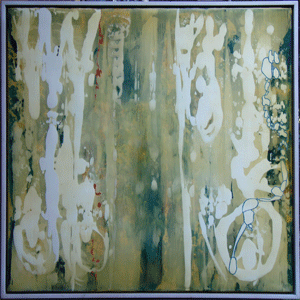
Leave a comment